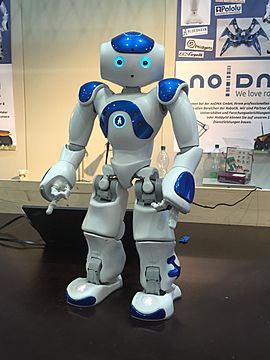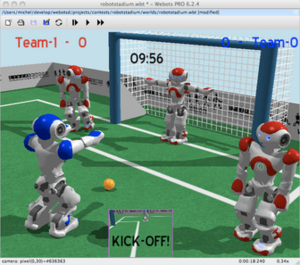Nao (robot) facts for kids
NAO (pronounced now) is a cool, programmable robot that looks like a human. It was created by a French company called Aldebaran Robotics, which is now part of SoftBank Group. The idea for Nao started in 2004.
In 2007, Nao became the official robot for the RoboCup Standard Platform League (SPL). This is an international competition where robots play soccer. Nao has been used in RoboCup ever since!
Many different versions of Nao have been made since 2008. The Nao Academics Edition was first made for universities and labs to use for learning and research. It became available to everyone by 2011. Newer versions like the Nao Next Gen (2011) and Nao Evolution (2014) have also been released.
By 2015, more than 5,000 Nao robots were being used in over 50 countries around the world.
Contents
Nao in schools and science
Since 2011, over 200 schools and universities worldwide have used Nao robots. These include places like the University of Tokyo and Montana State University.
- Helping kids learn: In 2012, Nao robots helped teach children with autism in a UK school. Some kids found the robots, which look a bit like children, easier to connect with than people. Many British schools also use Nao robots to teach students about robots and how they work.
- Customer service: In 2015, a Japanese bank, Mitsubishi UFJ Financial Group, started trying out Nao robots to help customers.
- Learning about itself: In 2015, Nao robots were part of a cool experiment in New York. Three robots were told that two of them had been given a "dumbing pill." When asked which one hadn't, the robot that could speak figured it out by hearing its own voice! This showed a basic form of self-awareness.
- Memory for robots: Also in 2015, French scientists used Nao robots to test a special "memory system." This system could help train crews for the International Space Station and assist older patients.
Nao is a great robot for schools and colleges. It helps students learn how to program and understand how humans and robots can work together. In 2018, RobotLAB launched an online learning platform. It helps schools use Nao for subjects like STEM (Science, Technology, Engineering, and Math) and coding.
Nao in healthcare
Since it first came out, Nao has been used in different healthcare settings. This includes helping out in care homes and in schools that support health.
How Nao is designed
Nao robots can move in many ways, thanks to their "degrees of freedom" (DoF). This means how many joints and movements they have. Some Nao models have 2, 14, 21, or 25 ways to move.
All Nao Academics versions have special sensors. These include an inertial measurement unit (like a fancy compass and motion sensor) and four ultrasonic sensors. These sensors help Nao stay balanced and know where it is in a room. The versions that can walk also have sensors in their feet to feel force and two bumpers.
The Nao Evolution (2014) had stronger metal joints and better grip. It also had an improved sound system with four microphones to figure out where sounds were coming from. The newest version, NAO6, came out in 2018.
Nao's software
Nao robots run on a special Linux-based operating system called NAOqi. This system controls all of the robot's cool features:
- Hearing and speaking: Nao has four microphones for recognizing voices and figuring out where sounds are. It also has two speakers that let it talk in many languages.
- Seeing: Nao has two HD cameras for computer vision. This means it can recognize faces and shapes.
Nao also comes with special software tools. One is called Choregraphe, which is a visual tool for programming the robot. There's also a simulation program and a kit for developers. Nao can also work with other software like Microsoft Robotics Studio and Webots.
In 2018, RobotLAB released Engage! K12, an online platform to help schools use Nao for STEM and coding. In 2018, a Finnish company called Utelias Technologies released Elias Robot. This is an app that helps people learn languages using Nao.
Nao's specifications
| Robot Version | Nao Next Gen (V4) (2011) | Nao Evolution (V5) (2014) | Nao Power 6 (V6) (2018) |
|---|---|---|---|
| Height | 573 millimetres (22.6 in) | 574 millimetres (22.6 in) | |
| Weight | 5.182530 kilograms (11.42552 lb) | 5.305350006 kilograms (11.69629464 lb) | 5.48 kilograms (12.1 lb) |
| Power supply | lithium battery providing 27.6 Wh at 21.6V | lithium battery providing 48.6 Wh at 21.6V | lithium battery providing 62.5 Wh at 21.6V |
| Autonomy | 60 minutes (active use) | 90 minutes (active use) | |
| Degrees of freedom | 25 | ||
| CPU | Intel Atom Z530 @ 1.6 GHz | Intel Atom Z530 @ 1.6 GHz | Intel Atom E3845 Quad Core @ 1.91 GHz |
| RAM | 1 GB | 1 GB | 4 GB DDR3 |
| Storage | 2 GB Flash memory + 8 GB Micro SDHC | 2 GB Flash memory + 8 GB Micro SDHC | 32 GB SSD |
| Built-in OS | OpenNAO 1.12 (gentoo-based) | NAOqi 2.1 (gentoo-based) | NAOqi 2.8 (openembedded-based) |
| Compatible OS | Windows, Mac OS, Linux | ||
| Programming languages | C++, Python, Java, MATLAB, Urbi, C, .Net | ||
| Simulation environment | Webots | ||
| Cameras | Two MT9M114 72.6°DFOV cameras | Two MT9M114 72.6°DFOV cameras | Two HD OV5640 67.4°DFOV cameras |
| Sensors | 36 Magnetic Rotary Encoders (for precise movement), 2 gyrometers (for rotation), 1 accelerometer (for motion), 8 Force Sensitive Resistors (in feet), 2 foot bumpers, Sonar (for distance), 2 Infrared sensors, 4 microphones, 2 cameras, Capacitive sensor. | 36 Magnetic Rotary Encoders, 2 gyrometers, 1 accelerometer, 8 Force Sensitive Resistors, 2 foot bumpers, Sonar, 2 Infrared sensors, 4 microphones, 2 cameras, Capacitive sensor. | 36 Magnetic Rotary Encoders, 3-axis gyrometer, 3-axis accelerometer, 8 Force Sensitive Resistors, 2 foot bumpers, Sonar, 2 Infrared sensors, 4 microphones, 2 cameras, Capacitive sensor. |
| Connectivity | Ethernet, Wi-Fi IEEE 802.11 a/b/g/n | Ethernet, Wi-Fi IEEE 802.11 a/b/g/n | |
See also
 In Spanish: Nao (robot) para niños
In Spanish: Nao (robot) para niños



